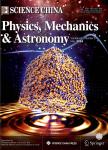A giant central red disk galaxy at redshift z=0.76:Challenge to theories of galaxy formation
A giant central red disk galaxy at redshift z=0.76:Challenge to theories of galaxy formation作者机构:Department of AstronomySchool of Physics and AstronomyShanghai Jiao Tong UniversityShanghai200240China Tsung-Dao Lee InstituteShanghai Key Laboratory for Particle Physics and CosmologyShanghai Jiao Tong UniversityShanghai200240China Canada Research ChairDepartment of Astronomy&Physics and the Institute for Computational AstrophysicsSaint Mary’s UniversityHalifaxB3H 3C3Canada NRC-Herzberg Astronomy and AstrophysicsNational Research Council of CanadaVictoriaV9E 2E7Canada
出 版 物:《Science China(Physics,Mechanics & Astronomy)》 (中国科学:物理学、力学、天文学(英文版))
年 卷 期:2021年第64卷第7期
页 面:137-141页
核心收录:
学科分类:07[理学] 070401[理学-天体物理] 0805[工学-材料科学与工程(可授工学、理学学位)] 0704[理学-天文学]
基 金:supported by National Natural Science Foundation of China (Grant Nos. 11533006, 11621303, 11890691, 11933003, and 11833005) funded by the National Astronomical Observatories, Chinese Academy of Sciences, and the Special Fund for Astronomy from the Ministry of Finance
主 题:disk galaxies galaxy quenching massive galaxies
摘 要:We report a giant red central disk galaxy in the XMM-LSS north region. The region is covered with a rich variety of multi-band photometric and spectroscopic observations. Using the photometric data of the Canada-France-Hawaii Telescope Legacy Survey(CFHTLS) and spectroscopic observation of the baryon oscillation spectroscopic survey(BOSS), we find that the galaxy has a stellar mass of ~1011.6 M⊙. The galaxy has a red color and has an old stellar population, and thus its star formation has *** the photometric image data of the Hyper Suprime-Cam(HSC) Subaru Strategic Program, we demonstrate that its luminosity profile is perfectly described by a Sérsic form with n=1.22 consistent with that of a disk. We also analyze its environment based on the VIMOS Public Extragalactic Redshift Survey(VIPERS) photometric catalog, and find that its close neighbors are all less massive, indicating that our observed galaxy is sitting at the center of its dark matter host halo. Existence of such a giant red central disk galaxy seriously challenges the current standard paradigm of galaxy formation, as there is no known physical mechanism to explain the quenching of its star formation. This conclusion is supported by state-of-the-art hydrodynamical simulations of galaxy formation.



